Ncert Solution Of Haloalkane and Haloarene: We shall learn about the compounds which are halogen derivatives of hydrocarbons. This is very important chapter for class 12th. It is the first chapter of organic chemistry. We shall know to solve all the Intext and exercise questions asked in this chapter. You should solve all the questions being asked in this chapter very carefully. You will get confidence and skills to solve easily questions of the other chapters of organic compounds for class 12th.
The compounds of this chapter are very useful in our daily life. For example, the chlorine containing antibiotics chloromycetin is very effective for the treatment of typhoid. Some synthetic halogen compounds are very useful in health care and medicines. For example chloroquine is used for the treatment of malaria fever. Many synthetic organic halogen compounds are extensively used in agriculture and industry. Therefore, in this chapter, we have to learn a lot of concepts for preparation, properties and Uses of halogen compounds.
Ncert Solution Of Haloalkane and Haloarene: Learning Objectives
- To name Haloalkanes and Haloarenes according to the IUPAC system of nomenclature from their given structures.
- To describe the reactions involved in the preparation of haloalkanes and haloarenes and understand the various reactions they undergo.
- To correlate the structure of haloalkanes and haloarenes with various types of reactions.
- To use stereochemistry as a tool for understanding reaction mechanism.
- To understand the application of organometallic compounds.
- To highlight the environmental effects of polyhalogen compounds.
Answers of Intext questions of Ncert Solution Of Haloalkane and Haloarene
Question 1. Write structures of the following compounds:
(i) 2-Chloro-3-methylpentane
(ii) 1-Chloro-4-ethylcydohexane
(iii) 4-tert. Butyl-3-iodoheptane
(iv) 1,4-Dibromobut-2-ene
(v) 1-Bromo-4-sec. butyl-2-methylbenzene.
Answer: 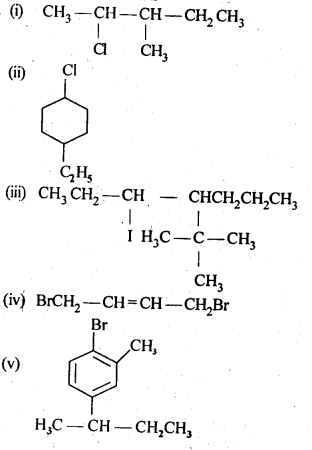
Question 2. Why is sulphuric acid not used during the reaction of alcohols with KI?
Answer: H2SO4 is an oxidising agent. It oxidises HI to produce I2 during the reaction 
and hence this prevents the reaction between an alcohol and HI to form an alkyl iodide. To overcome this difficulty, a non oxidising acid such as H3PO4 is used instead of H2SO4. 
Question 3. Write structures of different dihalogen derivatives of propane.
Answer: There are four isomeric dihalogen derivatives of propane are possible. They are followings: 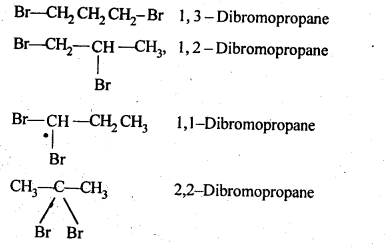
Question 4. Among the isomeric alkanes of molecular formula C5H12, identify the one that on photochemical chlorination yields
(i) A single monochloride.
(ii) Three isomeric monochlorides.
(iii) Four isomeric monochlorides.
Answer: 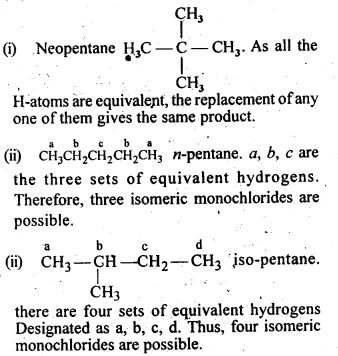
Question 5. Draw the structures of major monohalo products in each of the following reactions: 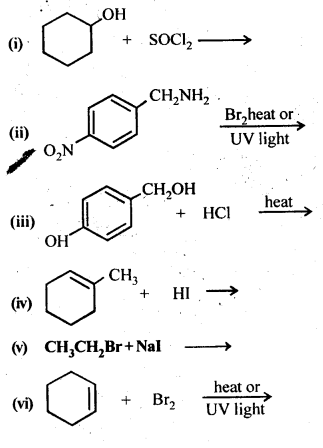 Answer:
Answer: 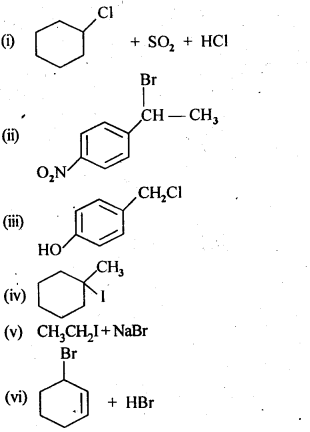
Question 6. Arrange each set of compounds in order of increasing boiling points :
(i) Bromomethane, bromoform, chloromethane, dibromomethane
(ii) 1- Chloropropane, isopropylchloride, 1- chlorobutane.
Answer: (i) For the same alkyl group, boiling point increases with the size of the halogen atom. Therefore, boiling point of bromomethane is higher than of chloromethane. Further, the boiling points increase as the number of halogen atoms increases. Therefore, combining all the arguments presented above the order of increasing boiling points will be chloromethane < bromomethane < dibromomethane < bromoform.
(ii) For the same halogen, boiling point increases as the size of the alkyl group increases. Further the boiling point decreases as the branching increases Therefore, the overall result for the order of the increasing boiling point will be as: isopropyl chloride < 1- chloropropane < 1- chlorobutane.
Question 7. Which alkyl halide from the following pairs would you expect to react more rapidly by an SN2 mechanism? Explain your answer. 
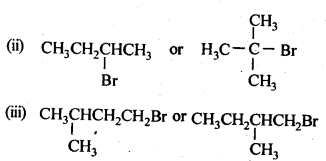
Answer: (i) CH3CH2CH2CH2Br is 1o alkyl halide while CH3CH2CH(Br)CH3 is a 2o alkyl halide. There will be some steric hindrance in 2o alkyl halides than in 1o alkyl halides. Therefore, CH3CH2CH2CH2 Br will react faster than CH3CH2CH(Br) CH3 in SN2 reaction.
(ii) CH3CH2CH(Br) CH3 is a 2o alkyl halide while (CH3)3C— Br is 3o alkyl halide. Since due to lesser steric hindrance, 2o alkyl halide reacts faster than 3o alkyl halide, therefore, CH3CH2CH(Br) CH3 will react faster than (CH3)3C— Br In SN2 reaction.
(iii) Both l and ll are 2o alkyl halide. But in alkyl halide (ll), the CH3 group at C2 is closer to the Br- atom while in alkyl halide (l), the CH3 group at C3 is little away from the Br- atom. As a result, alkyl halide (ll)will suffer greater steric hindrance than alkyl halide (l). Therefore alkyl halide (l) will react faster than alkyl halide (ll)
Question 8. In the following pairs of halogen compounds, which compound undergoes faster SN1 reaction? 
Answer: 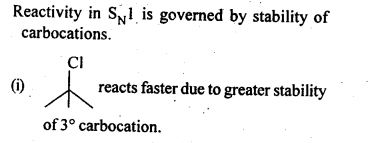

Question 9. Identify A, B, C, D, E, R and R1 in the following: 
Answer: 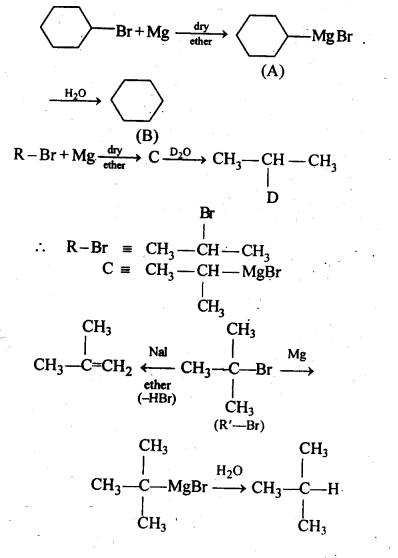
Answers of Exercise Questions: Ncert Solution Of Haloalkane and Haloarene
Question 1. Name the following halides according to the IUPAC system and classify them as alkyl, allyl, benzyl (primary, secondary, tertiary), vinyl, or aryl halides:
(i)(CH3)2CHCH(Cl)CH3
(ii) CH3CH2CH(CH3)CH(C2H5)CI
(iii) CH3CH2C(CH3)2CH2I
(iv)(CH3)3CCH2CH(Br)C6H5
(v)CH3CH(CH3)CH(Br)CH3
(vi)CH3C(C2H5)2CH2Br
(vii)CH3C(Cl)(C2H5)CH2CH3
(viii)CH3CH=C(CI)CH2CH(CH3)2
(ix)CH3CH=CHC(Br)(CH3)2
(x)P-CIC6H4CH2CH(CH3)2
(xi)m-ClCH2C6H4CH2C(CH3)3
(xii)o-Br -C6H4CH (CH3)CH2CH3
Answer: (i) 2-Chloro-3methylbutane, 2° alkyl halide
(ii) 3-Chloro-4methyl hexane, 2° alkyl halide
(iii) 1 -Iodo-2,2-dimethylbutane, 1 ° alkyl halide
(iv) l-Bromo-3, 3-dimethyl -1-phenylbutane, 2° benzylic halide
(v) 2-Bromo-3-methylbutane, 2° alkyl halide
(vi) 1-Bromo-2-ethyI-2-methylbutane, 1° alkyl halide
(vii)3-Chloro-3-methylpentane, 3° alkyl halide
(viii) 3-Chloro-5-methylhex-2-ene, vinylic halide
(ix)4-Bromo-4-methylpent-2-ene, allylic halide
(x)1-Chloro-4-(2-methylpropyl) benzene, aryl halide
(xi)1-Chloromethyl-3- (2,2-dimethylpropyl) benzene, 1 ° benzylic halide.
(xii)1-Bromo-2-(l-methylpropyl) benzene,aryl halide.
Question 2. Give the IUPAC names of the following compounds:
(i) CH3CH(CI)CH (Br)CH3 (ii) CHF2CBrCIF (iii) CICH2C=CCH2Br (iv) (CCl3)3CCl
(v)CH3C(p-ClC6H4)2CH(Br)CH3 (vi)(CH3)3CCH=C(CI)C6H4I -p
Answer: (i) 2-Bromo-3-chlorobutane
(ii) 1-Bromo-1 -chloro-1,2,2-trifluoroethane
(iii) 1-Bromo-4-chlorobut-2-yne
(iv)2-(Trichloromethyl)-l, 1,1,2,3,3,3- heptachloropropane
(v)2-Bromo-3,3-bis-(4-chlorophenyl) butane
(vi)l-Chloro-l-(4-iodophenyl)-3,3- dimethylbut-l-ene.
Question 3. Write the structures of the following organic halogen compounds:
(i)2-ChIoro-3-methylpentane
(ii)p-Bromochlorobenzene
(iii)1-Chloro-4-ethylcyclohexane
(iv)2- (2-Chlorophenyl) -1- iodooctane
(v)2-Bromobutane
(vi)4-tert-Butyl-3-iodoheptane
(vii)1-Bromo-4-sec-butyl-2-methylbenzene
(viii)1,4-Dibromobut-2-ene
Answer: 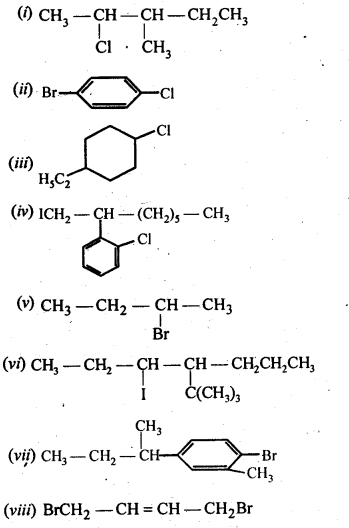
Question 4. Which one of the following has the highest dipole moment?
(i)CH3CI2 (ii) CHCl3 (iii) CCI4
Answer: The three dimensional structures of the three compounds along with the direction of dipole moment in each of their bonds can be 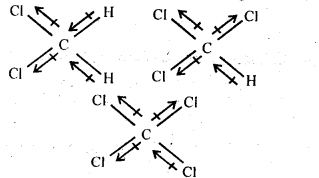
CCl4 being symmetrical has zero dipole moments. In CHCl3, the resultant of two C–Cl dipole is opposed by the result of C–H and C–Cl bond. Since the latter resultant is expected to be smaller than the former. CHCl3 has a finite dipole (1.03) moment.
In CH2Cl2, the resultant of two C–Cl dipole moment is opposed by resultant of two C–H dipole, therefore, CH2Cl2 (1.62) has a dipole moment higher than that of CHCl3. Thus CH2Cl2 has the highest dipole moment.
Question 5. A hydrocarbon C5H10 does not react with chlorine in dark but gives a single monochloro compound C5H9CI in bright sunlight. Identify the hydrocarbon.
Answer: The hydrocarbon with M.F. C5H10 can be either a cycloalkane or an alkene. Since the hydrocarbon does not react with Cl2 in dark. It can not be an alkene but must be a cycloalkane. Since, the cycloalkane reacts Cl2 in the presence of bright sunlight to give a monochloro compound C5H9Cl. Therefore, all the ten hydrogen atoms of the cycloalkane must be equivalent. Thus the cycloalkane is cyclopentane. 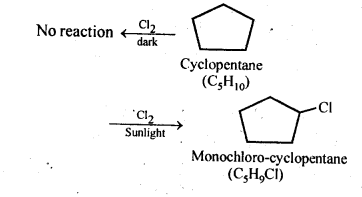
Question 6. Write the isomers of the compound having formula C4H9Br.
Answer: 
Question 7. Write the equations for the preparation of 1-iodoobutanefrom (i)1-butanol (ii)1-chlorobutane (iii) but-l-ene.
Answer: 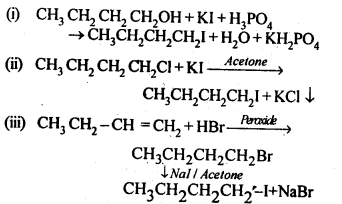
Question 8. What are ambident nucleophiles ? Explain with an example.
Answer: Nucleophiles which can attack through two different sites are called ambident nucleophiles. For example, cyanide ion is a resonance hybrid of the following two structures: ![]()
It can attack through carbon to form cyanide and through N to form is O cyanide. Another example is ←NO2.
Question 9. Which compound in each of the following-pairs . will react faster in SN2 reaction with -OH? (i)CH3Br or CH3I
(ii)(CH3)3CCl or CH3Cl
Answer: (i) Since I– ion is a better leaving group than Br- ion, therefore, CH3I reacts faster than CH3Br in SN2 reaction with OH– ion.
(ii)Due to steric hindrance, 1° alkyl halides are more reactive than tert-alkyl halides in SN2 reactions. Therefore, CH3CI will react faster than (CH3)3CCl in a SN2 reaction with OH– ion.
Question 10. Predict all the alkenes that would be formed by dehydrohalogenation of the following halides with sodium ethoxide in ethanol and identify the major alkene:
(I) 1-Bromo-l-methylcyclohexane
(ii) 2-Chloro-2-methylbutane.
(iii) 2,2,3-Trimethyl-3-bromopentane.
Answer: 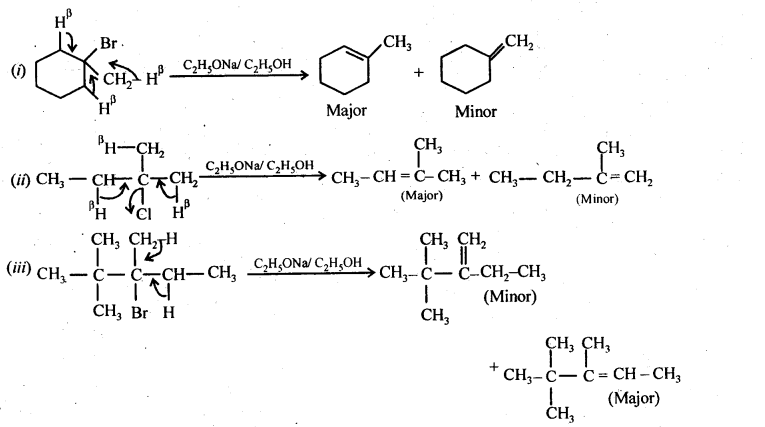
Question 11. How will you bring about the following conversions?
(I) Ethanol to but-l-yne.
(ii) Ethane to bromoethene
(iii) Propene to 1-nitropropane
(iv) Toluene to benzyl alcohol
(v) Propene to propyne
(vi) Ethanol to ethyl fluoride
(vii) Bromomethane to propanone
(viii) But-l-ene to but-2-ene
(ix) 1-Chlorobutane to n-octane
(x) Benzene to biphenyl
Answer: 
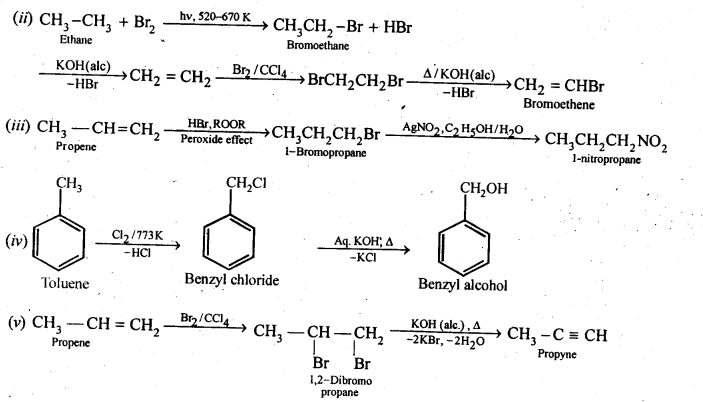
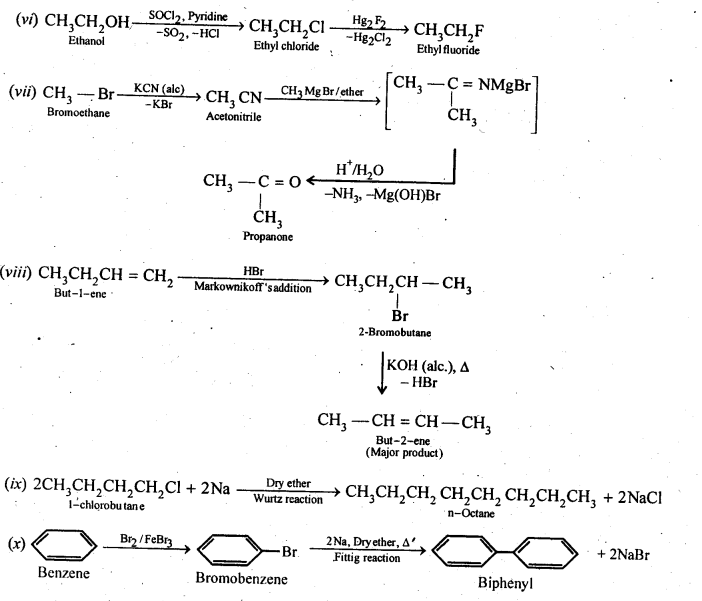
Question 12. Explain why
(i) the dipole moment of chlorobenzene is lower than that of cyclohexyl chloride?
(ii) alkyl halides, though polar, are immiscible with water?
(iii) Grignard reagents should be prepared under anhydrous conditions?
Answer:(i) There are following reasons which justify that the dipole moment of chlorobenzene is lower than that of cyclohexyl chloride :
- Greater s-character which makes more stronger C – Cl bond in Chlorobenze than that of cyclohexyl chloride.
- Double bond character between C – Cl bond in Chlorobenze while single bond is present between C – Cl in Cyclohexyl chloride.
- Overall the above characters make the C – Cl bond stronger and less polar to Chlorobenze w.r.t. cyclohexyl chloride.
(ii) Alkyl halides are polar molecules and they are held together by dipole-dipole attraction. The molecule of H2O are held together by H-bond. Since the new force of attraction between water and alkyl halide molecules are weaker than the force of attraction already existing between alkyl halide – alkyl halide molecules and water – water molecules, therefore, alkyl halides are immiscible with water.
(iii) Grignard reagents are very reactive. They react with moisture present in the apparatus or reacting materials and form alkane instead of desirable products. Therefore, grignard reagents must be prepared under anhydrous conditions.
Question 13. Give the uses of freon 12, DDT, carbon tetrachloride, and iodoform.
Answer: Iodoform (CHI3): This chemical was earlier used as an antiseptic. the antiseptic properties of iodoform are due to the liberation of free iodine and not due to iodoform itself. Due to it’s bad smell, it has been replaced by other compounds containing iodine.
Carbon tetrachloride (CCl4 )
(i) It is used as an industrial solvent for oil, fats, resins etc. and also in dry cleaning.
(ii) The vapours of CCl4 are highly non-inflammable, thus it is used as a fire extinguisher under the name of pyrene.
(iii) It is also used in the manufacture of refrigerants and propellants for aerosol cans.
Freons: The general formula of most common freons is Freon-12 (CCl2F2). It is generally used for aerosol propellants, refrigeration, and air conditioning purposes.
DDT (p -p’ – Dichloro diphenyl – trichloro ethane):
(i) It was used against the mosquitoes that spreads malaria and other insects which damages crops after second world war.
(ii) However, there was problems related to extensive use of DDT which began to appear in the late 1940 s. Many species of insects developed resistance to DDT,
it was also discovered to have a high toxicity towards fishes. DDT is not metabolized very rapidly by animals, instead, it is deposited and stored in the fatty tissues. If the ingestion continues at a steady rate, DDT builds up within the animal’s overtime which proved dangerous for other living things and hence banned later.
Question 14. Write the structure of the major organic product in each of the following reactions: 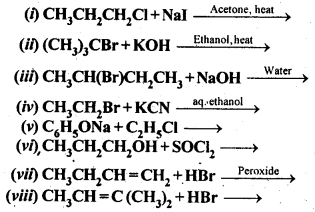
Answer: 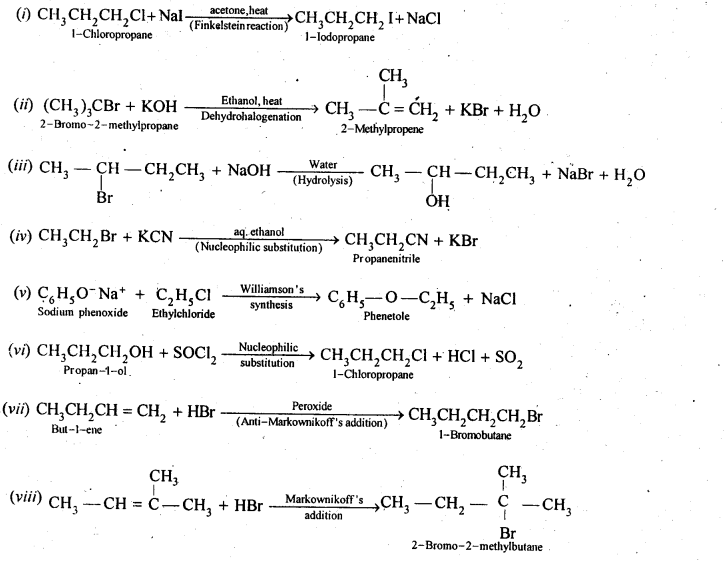
Question 15. Write the mechanism of the following reaction: ![]()
Answer: The cyanide group in KCN is a resonance hybrid of the following two contributing structures.![]()
This activity of CN– ion show that it is an ambident nucleophile. Therefore, it can attack the “carbon atom of C-Br bond in n-BuBr either through C or N. Since C – C bond is stronger than C – N bond, therefore, attack takes place through C to form n-butyl cyanide. 
Question 16. Arrange the compounds of each set in order of reactivity towards SN2 displacement:
(i) 2-Bromo-2-methyibutane, 1-Bromopentane, 2-Bromopentane.
(ii) l-Bromo-3-methyIbutane, 2-Bromo-2-methylbutane, 3-Bromo-2-methylbutane.
(iii) 1-Bromobutane, l-Bromo-2,2-dimethylpropane, l-Bromo-2-methylbutane, l-Bromo-3-methyl butane.
Answer: The reactivity of SN2 reactions depends upon steric hindrance. More the steric hindrance slower the reaction. Thus the order of reactivity will be 1°> 2° >3° 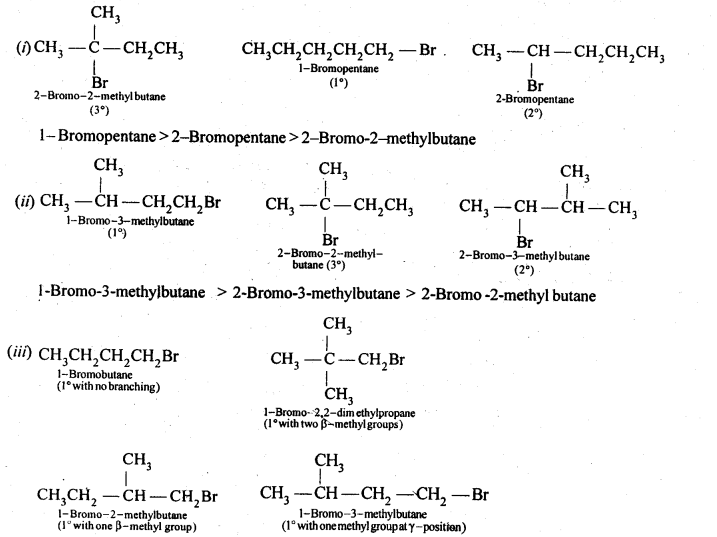
Since in case of 1° alkyl halides, steric hindrance increases in the order: n-alkyl halides, alkyl halides with a substituent at any position other than the β-position, one substituent at the β-position, two substituents at the β-position, therefore, the reactivity decreases in the same order. Thus, the reactivity of the given alkyl bromides decreases in the order:
1-Bromobutane > l-Bromo-3-methylbutane > l-Bromo-2-methyjbutane> 1-Bromo-2,2-dimethyl propane.
Question 17. Out of C6H5CH2Cl and C6H5CHCIC6H5which is more easily hydrolysed by aqueous KOH.
Answer: C6H5CH2Cl is 1o aryl halide while C6H5CH(CI)C6H5 is a 2° aryl halide. In SN1 reactions, the reactivity depends upon the stability of carbocations. 
Since the C6H5CH+C6H5carbocation is more stable than C6H5CH2+ carbocation, therefore,C6H5CHCIC6H5 gets hydrolysed more easily than C6H5CH2Cl under SN1 conditions.
Question 18. p-dichlorobenzene has higher m.p. and lesser solubility than those of o-and m-isomers. Discuss.
Answer: There are three position isomers of dichlorobenzene which differ in the relative positions of the chlorine atoms in the following way: 
As we know that, p-isomer is more symmetrical than the other isomers of dichlorobenzene. This means that in the crystal lattice, molecules of the p-isomers are more closely packed as compared to the other isomers. As a result, it has a higher melting point and lower solubility than ortho and meta isomers. The reason of low solubility is that it has zero dipole moment hence, it is non- polar but water is polar.
Question 19. How the following conversions can be carried out:
(i) Propene to propan-l-ol (ii) Ethanol to but-l-yne
(iii) l-Bromopropane to 2-bromopropane (iv) Toluene to benzyl alcohol
(v)Benzene to 4-bromonitrobenzene (vi) Benzyl alcohol to 2-phenylethanoic acid
(vii)Ethanol to propanenitrile (viii) Aniline to chlorobenzene (ix)2-Chlorobutane to 3,4-dimethylhexane (x) 2-Methyl-1 -propene to 2-chk>ro-2-methylpropane.
(xi)Ethyl chloride to propanoic acid (xii) But-1-ene to n-butyliodide
(xiii)2-Chlropropane to 1-propanol (xiv) Isopropyl alcohol to iodoform
(xv)Chlorobenzene to p-nitrophenol (xvi) 2-Bromopropane to 1-bromopropane
(xvii)Chloroethane to butane , (xviii) Benzene to diphenyl
(xix) tert-Butyl bromide to isobutyl bromide (xx) Aniline to phenylisocyanide
Answer: 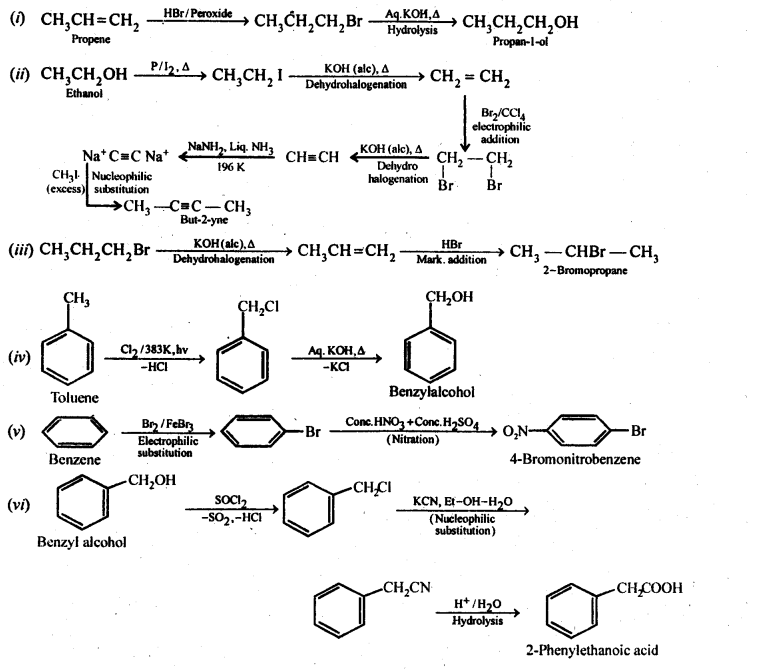
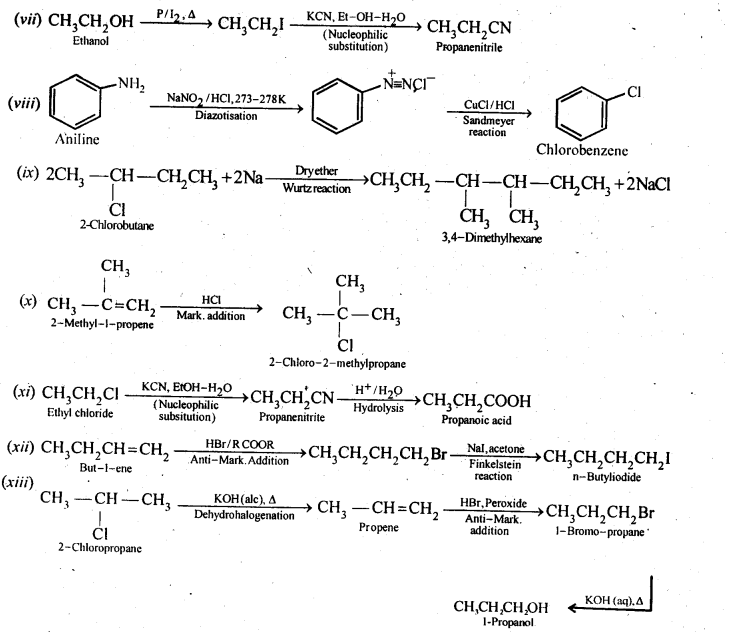
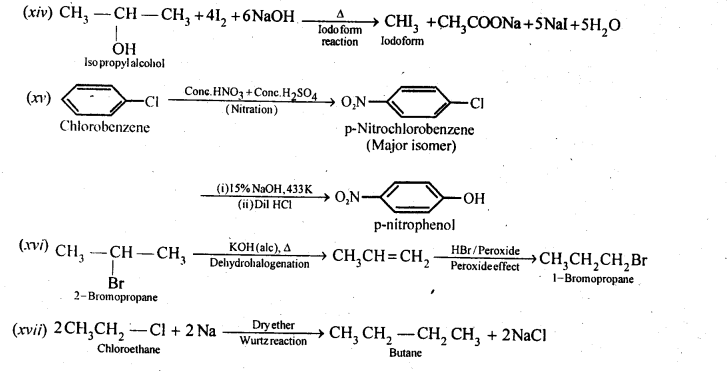
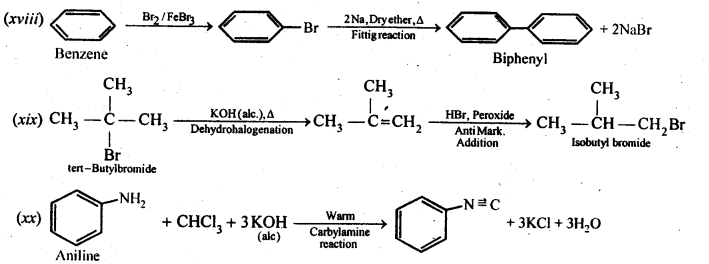
Question 20. The treatment of alkyl chlorides with aqueous KOH leads to the formation of alcohols but in presence of alcoholic KOH, alkenes are major products. Explain.
Answer: In aqueous medium i.e., water, KOH will completely dissociate to give OH– ions. They are strong nucleophiles, hence, they will bring about the substitution of alkyl halides to form alcohols. At the same time, the OH– ions will be highly hydrated. They will not be able to abstract a proton (H+) from the β-carbon atom to form alkenes. In other words, in aqueous medium, OH– ions will behave as weak base and elimination leading to alkenes will not be feasible.
In alcoholic KOH, the solution will also contain ethoxide ions (C2H5O–) in addition to OH– ions. They being a stronger base than OH– ions, will abstract a H+ ion from the β-carbon atom giving alkene as the product as a result of dehydrohalogenation.
Question 21. Primary alkyl halide C4H9Br (a) reacted with alcoholic KOH to give compound (b) Compound (b) is reacted, with HBr to give (c) which is an isomer of (a). When (a) is reacted with sodium metal it give compound (d), C8H18 which is different from the compound formed when n-butyl bromide is reacted with sodium. Give the structural formula of (a) and write the equations for all the reactions.
Answer: (i) There are the possibility of two primary alkyl halides having the molecular formula, C4H9Br.
(ii) Since compound (a) when reacted with Na metal gives a compound (d) with molecular formula C8H18 which is different from the compound obtained when n-butyl bromide was reacted with Na metal, therefore, (a) must be isobutyl bromide and compound (d) must be 2,3-dimethylhexane. 
(iii) If compound (a) is isobutyl bromide, than the compound (b) which it gives on treatment with alcoholic KOH must be 2-methyl-1-propane. 
(iv) The compound (b) on treatment with HBr gives compound (c) in accordance with Markownikoff rule. Therefore, compound (c) is tert-butyl bromide which is an isomer of compound (a) ,i.e., isobutyl bromide. 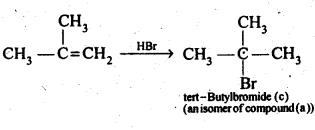
Thus
(a)is isobutyl bromide,
(b)is 2-methyl-1 -propane,
(c)is tert-butylbromide, and
(d)is 2,5-dimethylhexane.
Question 22. What happens when .
(i) n-butyl chloride is treated with alcoholic KOH.
(ii) bromobenzene is treated with Mg in the presence of dry ether.
(iii) chlorobenzene is subjected to hydrolysis.
(iv) ethyl chloride is treated with aqueous. KOH.
(v) methyl bromide is treated with sodium in the presence of dry ether,
(vi) methyl chloride is treated with KCN.
Answer: 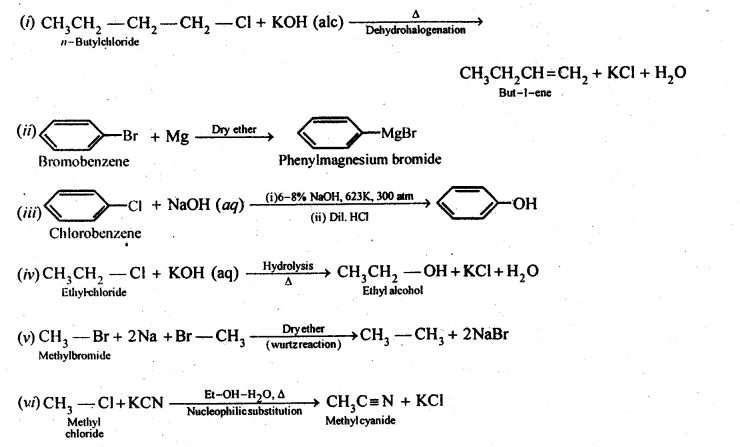
Conclusion of Ncert Solution Of Haloalkane and Haloarene
Thank you my friends for approaching this site. We hope that you have felt much enjoy in solving the problems of Haloalkanes and Haloarenes. We have tried our best to upload the answer of all the questions whether Intext or exercise. Ncert Solution Of Haloalkane and Haloarene will prove very helpful.
If you have liked this notes. Then you are requested to share this article among your friends and favourites. Thank you very much.

